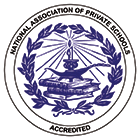5th Grade Christian Homeschool Curriculum
Scope & Sequence - 5th Grade Christian Homeschool Curriculum
Math Grade 5 (PACEs 1049–1060)
The student:
Defines and identifies new math terms: quotient, dividend, numerator, and denominator.
Uses addition, subtraction, division, and multiplication with fractions; identifies proper and improper fractions; and reduces fractions to lowest terms.
Factors numbers from least to greatest, and finds the Greatest Common Factor (GCF) and the Least Common Denominator (LCD) of fractions.
Recognizes the place value of each digit in numbers up to thousands.
Learns to represent and compare whole numbers and decimals.
Learns the commutative properties of addition and multiplication and estimation.
Compares numbers, sentences, words, decimals, and fractions using > and < symbols.
Defines and identifies prime numbers.
References charts, pictographs, and line graphs. n Writes Roman numerals 1–399.
Learns basic geometry—points, lines, rays, and angles; identifies geometric shapes; identifies similar and congruent figures; and finds the volume, perimeter, and area of figures.
Learns about probabilities and ratios.
Processes simple unit conversions such as centimeters to meters within a system of measurement.
English Grade 5 (PACEs 1049–1060)
The student:
Expands his knowledge of nouns and verbs and learns the agreement of subjects and verbs.
Learns to diagram the subject, action verb, state-of-being verb, predicate noun, adjectives, adverbs, and direct object of a sentence.
Identifies and correctly uses verbs that are often misused, modifiers, and pronouns.
Changes a given list of verbs from singular to plural.
Reviews pronouns and identifies the kinds (personal, interrogative, demonstrative, and indefinite) and cases (subjective, objective, and possessive).
Recognizes simple and complete subjects and predicates.
Is introduced to predicate adjectives and comparative degrees of adverbs.
Recognizes complete sentences and fragments, learns four sentence patterns, and develops paragraphs.
Learns and practices punctuation rules including quotation marks, underlining titles, etc.
Increases word concepts (antonyms, synonyms, homonyms) and learns about heteronyms.
Writes business and friendly letters.
Demonstrates a mastery of proper capitalization.
Is encouraged in character development through examples given in each PACE.
Literature and Creative Writing Grade 5 (PACEs 1049–1060)
The student:
Adds to his knowledge of short story elements—setting, characters, plot, and order.
Learns about the four types of conflict in stories.
Discovers personification, alliteration, anagrams, analogies, antonyms, homonyms, homophones, similes, and metaphors.
Considers time order and narrative, cause and effect, point of view, comparison and contrast, and the difference between fact and opinion.
Distinguishes between topic sentences and supporting sentences and persuasive and descriptive writing.
Gains knowledge of the Far North and Africa, biomes, Morse code, the metric and English systems of measurement, and art terms and concepts.
Recognizes editing and proofreading marks.
Writes a book report and review and defines and writes anagrams and anecdotes.
Required resources:
Choice Stories for Children selected by Ernest Lloyd
North to Amaroqvik by Cheryl M. Ufkin
Heidi by Johanna Spyri
Ace and Christi Series—Miracle at Camp Friendship by Sarah Hopewell
A Dog of Flanders by Marie Louise De La Ramée
Star of Light by Patricia M. St. John
Social Studies Grade 5 (PACEs 1049–1060)
The student:
Learns about systems of government, great leaders, wars, and current events affecting our world.
Learns Biblical truths—work is of God, possessions and true prosperity are from God, stewardship, entrusting one’s life to Jesus, faithfulness and loyalty, and obedience.
Discovers Christian leaders and missionaries in American history—John Eliot and Dr. Marcus Whitman.
Studies early American history to present history:
Early explorers England’s influence Homestead and Railroad Acts
Early settlements George Washington Monroe Doctrine
American Independence Civil War and Reconstruction
Missionaries Industrial Revolution Korean, Vietnam, and Persian
American Immigration Great Depression Gulf Wars
World Wars I and II American presidents War on Terror
Uses a time line and completes map studies.
Reviews heroes from the Bible—Daniel and Nebuchadnezzar, Abraham and Sarah, the virtuous woman, and Solomon and his Proverbs.
Learns states and their capitals.
Is encouraged in character development through examples given in each PACE.
Science Grade 5 (PACEs 1049–1060)
The student:
Explores living and nonliving matter and active, dormant, and extinct volcanoes.
Learns about energy—work, force, kinetic, potential, and radiant energy.
Studies oceanography, astronomy, comets, and the aurora borealis and aurora Australis.
Studies the outer, inner, and middle ear; hearing difficulties; and vibration, pitch, and frequency of sounds.
Studies molecular and atomic theories; friction, heat, and gravity; and expansion and contraction.
Views dinosaurs and fossils from a Biblical perspective.
Learns the relationship between the Bible and botany, meteorology, and zoology.
Discovers the Bible to be the final authority in scientific matters.
Learns new vocabulary words in each PACE.
Is encouraged in character development through examples given in each PACE.
Word Building Grade 5 (PACEs 1049–1060)
The student:
Identifies parts of speech—nouns, verbs, and present and past tenses.
Recognizes syllable divisions and accents.
Evaluates root words, prefixes, and suffixes.
Forms plurals by changing the endings.
Is encouraged in character development through examples given in each PACE.
Bible Reading Grade 5 (PACEs 1049–1060)
The student:
Focuses on reading Acts, Genesis, Exodus, and begins Psalms.
Reviews names of all the books of the Bible.
Practices personalizing and meditating on Scripture.
Learns interesting Bible facts.

